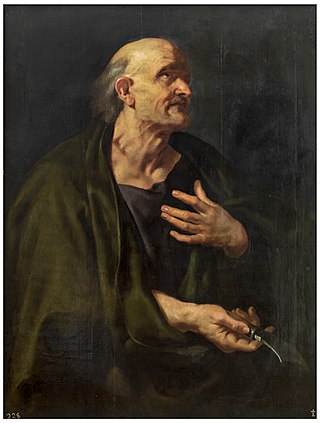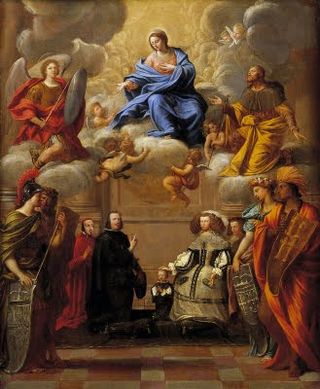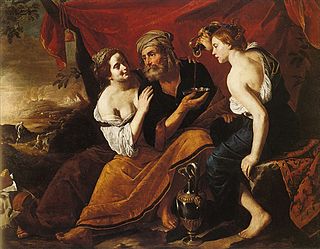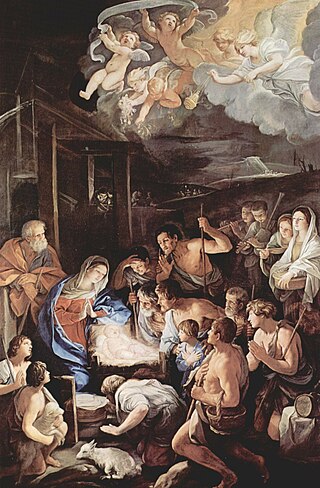
Michelangelo Merisi da Caravaggio, known mononymously as Caravaggio, was an Italian painter active in Rome for most of his artistic life. During the final four years of his life, he moved between Naples, Malta, and Sicily until his death. His paintings have been characterized by art critics as combining a realistic observation of the human state, both physical and emotional, with a dramatic use of lighting, which had a formative influence on Baroque painting.

John the Apostle, also known as Saint John the Beloved and, in Eastern Orthodox Christianity, Saint John the Theologian, was one of the Twelve Apostles of Jesus according to the New Testament. Generally listed as the youngest apostle, he was the son of Zebedee and Salome. His brother James was another of the Twelve Apostles. The Church Fathers identify him as John the Evangelist, John of Patmos, John the Elder, and the Beloved Disciple, and testify that he outlived the remaining apostles and was the only one to die of natural causes, although modern scholars are divided on the veracity of these claims.

Bartholomew was one of the twelve apostles of Jesus according to the New Testament. Most scholars today identify Bartholomew as Nathanael or Nathaniel, who appears in the Gospel of John.

Luca Giordano was an Italian late-Baroque painter and printmaker in etching. Fluent and decorative, he worked successfully in Naples, Rome, Florence, and Venice, before spending a decade in Spain.

Guido Reni was an Italian painter of the Baroque period, although his works showed a classical manner, similar to Simon Vouet, Nicolas Poussin, and Philippe de Champaigne. He painted primarily religious works, but also mythological and allegorical subjects. Active in Rome, Naples, and his native Bologna, he became the dominant figure in the Bolognese School that emerged under the influence of the Carracci.

The Caravaggisti were stylistic followers of the late 16th-century Italian Baroque painter Caravaggio. His influence on the new Baroque style that eventually emerged from Mannerism was profound. Caravaggio never established a workshop as most other painters did, and thus had no school to spread his techniques. Nor did he ever set out his underlying philosophical approach to art, the psychological realism which can only be deduced from his surviving work. But it can be seen directly or indirectly in the work of Rubens, Jusepe de Ribera, Bernini, and Rembrandt. Famous while he lived, Caravaggio himself was forgotten almost immediately after his death. Many of his paintings were re-ascribed to his followers, such as The Taking of Christ, which was attributed to the Dutch painter Gerrit van Honthorst until 1990.

Jusepe de Ribera was a Spanish painter and printmaker. Ribera, Francisco de Zurbarán, Bartolomé Esteban Murillo, and the singular Diego Velázquez, are regarded as the major artists of Spanish Baroque painting. Referring to a series of Ribera exhibitions held in the late 20th century, Philippe de Montebello wrote "If Ribera's status as the undisputed protagonist of Neapolitan painting had ever been in doubt, it was no longer. Indeed, to many it seemed that Ribera emerged from these exhibitions as not simply the greatest Neapolitan artist of his age but one of the outstanding European masters of the seventeenth century." Jusepe de Ribera has also been referred to as José de Ribera, Josep de Ribera, and Lo Spagnoletto by his contemporaries, early historians, and biographers.

The Denial of Saint Peter(La Negazione di Pietro) is a painting finished around 1610 by the Italian painter Caravaggio. It depicts Peter denying Jesus after Jesus was arrested. The painting is housed in the Metropolitan Museum of Art in New York City.

Giovanni Battista Caracciolo (1578–1635) was an Italian artist and important Neapolitan follower of Caravaggio. He was a member of the murderous Cabal of Naples, with Belisario Corenzio and Giambattista Caracciolo, who were rumoured to have poisoned and disappeared their competition for painting contracts.

Mattia Preti was an Italian Baroque artist who worked in Italy and Malta. He was appointed a Member of the Order of Saint John.

The Church and Convent of the Girolamini or Gerolamini is a church and ecclesiastical complex in Naples, Italy. It is located directly across from the Cathedral of Naples on via Duomo. The facade is across the homonymous piazza and street from Santa Maria della Colonna. It is one block west of Via Duomo.

The Harbaville Triptych is a Byzantine ivory triptych of the middle of the 10th century with a Deesis and other saints, now in the Louvre. Traces of colouring can still be seen on some figures. It is regarded as the finest, and best-preserved, of the "Romanos group" of ivories from a workshop in Constantinople, probably closely connected with the Imperial Court.

Massimo Stanzione was an Italian Baroque painter, mainly active in Naples, where he and his rival Jusepe de Ribera dominated the painting scene for several decades. He was primarily a painter of altarpieces, working in both oils and fresco. His main subject matter was biblical scenes. He also painted portraits and mythological subjects. He had many pupils and followers as his rich color and idealized naturalism had a large influence on other local artists, such as Francesco Solimena. In 1621 Pope Gregory XV gave him the title of Knight of the Golden Spur and Pope Urban VIII made him a knight of St. John around 1624 and a knight of the Order of Christ in 1627. From then on, he liked to sign his works as "EQUES MAXIMUS".
Agostino Beltrano was an Italian painter active in the Baroque period in his native city of Naples. He was a pupil of Massimo Stanzione, the uncle of his wife, and is known to have been active in 1646. He is said to have murdered his 36-year-old wife and painter, Aniella di Beltrano, in a fit of jealousy. He died in Naples.

Pietro del Pò, also spelled del Po, was an Italian painter, engraver, and draughtsman of the Baroque. He was more distinguished as an engraver than as a painter.

Hendrick de Somer (1602–c.1655) was a Flemish painter who spent most of his life and career in Italy. He was mainly active in Naples.

The Pio Monte della Misericordia is a church in the historic center of Naples, southern Italy. It is famous for its art works, including Caravaggio's The Seven Works of Mercy. A charity brotherhood was founded in August 1601 by seven young nobles, who met every Friday at the Hospital for Incurables and ministered to the sick.

In Christian theology and ecclesiology, the apostles, particularly the Twelve Apostles, were the primary disciples of Jesus according to the New Testament. During the life and ministry of Jesus in the 1st century AD, the apostles were his closest followers and became the primary teachers of the gospel message of Jesus. There is also an Eastern Christian tradition derived from the Gospel of Luke that there were seventy apostles during the time of Jesus' ministry.

The Pietà is a painting by José de Ribera, "The Españoleto", painted, signed and dated in 1633.

Adoration of the Shepherds is a c. 1642 oil on canvas painting by Guido Reni, commissioned by Giovan Battista Pisante, prior of the Certosa di San Martino in Naples, and still hanging on the main wall of the choir of that institution's church.



















